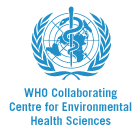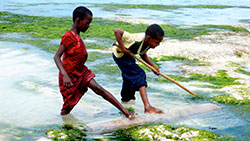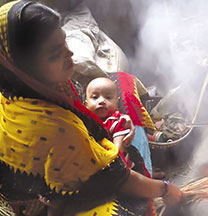
World Health Organization (WHO) Collaborating Centres enable WHO to extend its reach and bolster efforts to improve human health around the world. Building on over three decades of collaboration, NIEHS was formally designated as a WHO Collaborating Centre for Environmental Health Sciences in September 2013. The Collaborating Centre provides a focal point and resource for NIEHS to fulfill its strategic goals in global environmental health and help translate research findings into effective public health interventions. The Pan-American Health Organization (PAHO), the WHO Regional Office for the Americas, helps coordinate the activities of WHO Collaborating Centres in the Americas.
What Does the NIEHS Collaborating Centre Do?
Through the Centre, NIEHS assists WHO by:
- Promoting international cooperation among environmental health research institutes.
- Promoting global awareness of emerging issues in environmental health.
- Supporting education and training efforts in environmental and occupational health sciences.
In Fall 2021, NIEHS was redesignated as a WHO Collaborating Centre, and a new workplan concentrating on three focus areas was established:
Children's Environmental Health

Children's environmental health (CEH) is a branch of public health focused on promoting children’s safety and well-being by fostering healthy relationships between children and their environments.
Extensive research into CEH at NIEHS has increased understanding of the unique vulnerability of children to harmful environmental exposures and helped to guide the development of protective measures for children in the U.S. and around the world.
NIEHS founded and hosts the Network of WHO Collaborating Centres for Children's Environmental Health. The Network is made up of more than 12 Collaborating Centres and other leading research institutions and brings together CEH experts around the world to build CEH evidence and research capacity, coordinate and conduct collaborative research, raise awareness of CEH issues, and develop interventions to reduce childhood environmental exposures.
Additionally, the Network collaborates on publications and events that build and disseminate CEH knowledge. These efforts provide WHO with evidence-based resources and expertise needed to identify environmental risk factors for children and develop actions to address them. Network members, including NIEHS staff, have co-authored multiple CEH-focused publications, including:
Household Air Pollution

Nearly 3 billion people worldwide use biofuels, such as dung, brush, and wood, to cook with and heat their homes. Exposure to smoke from burning biomass causes nearly 4 million deaths per year, as well as other chronic health problems, including cardiovascular disease, stroke, and lung cancer. Women, who typically do the cooking, along with children under their care, are most vulnerable to household air pollution.
NIEHS and partners support the Household Air Pollution Intervention Network (HAPIN) Trial, a study across four countries to test the impact of using liquefied petroleum gas cooking stoves to reduce household air pollution and related health outcomes. Additionally, NIEHS and partners in the Clean Cooking Implementation Science Network are working to better understand the environmental, economic, behavioral, and other factors that affect the uptake and successful scale-up of clean cooking technologies.
The Centre hosts regional workshops to share lessons learned from the HAPIN Trial and Implementation Science Network. Additionally, Centre members will partner with PAHO to translate findings from the HAPIN Trial and Implementation Science Network to inform policy briefs that can help countries prioritize actions and interventions to reduce household air pollution.
Chemical Risk Assessment Network
Pollution is responsible for 1 in 6 premature deaths each year. To enhance global efforts to assess and minimize human health risks from exposure to chemicals, WHO created the Chemical Risk Assessment Network in 2013. The network brings together representatives of government agencies, researchers, and nongovernmental organizations to address the public health risks posed by chemical exposures.
NIEHS staff are active members of Network working groups focused on capacity building, systematic review, and emerging risks. The institute has played an important role in the Network since its inception, supporting:
- Network meetings that facilitate sustainable collaboration between institutions conducting chemical risk assessments.
- Creation of communication materials and sharing the latest research on emerging contaminants.
- Training in toxicology and exposure science to institutions in low- and middle-income countries.


